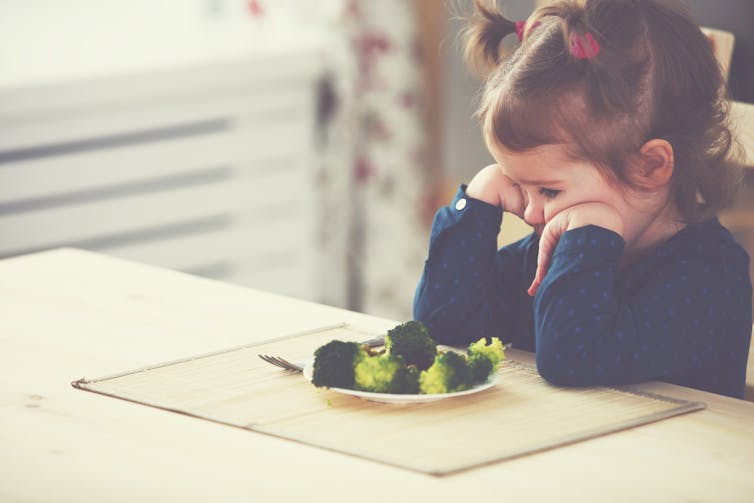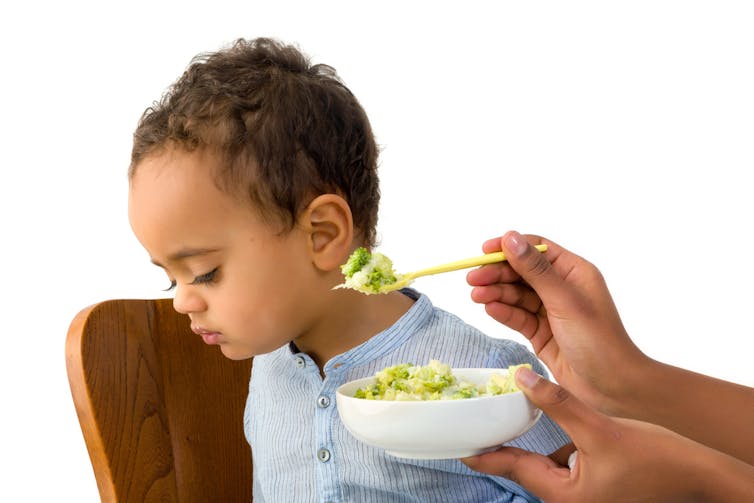
Holly Harris, The University of Queensland and Rebecca Byrne, Queensland University of Technology
If you have a child who is a fussy eater, you’re not alone. Almost half of all children will go through a fussy eating period in the early years. Rest assured, refusal of foods by young children is a normal stage of development.
In fact, food fussiness ensured the survival of our “cave-man” ancestors. Preference for sweet and fatty flavours prioritises energy storage (great in times of food scarcity) while rejection of unfamiliar foods or bitter flavours (most commonly found in vegetables) helps avoid ingestion of potential toxins.
Unlike our ancestors, we’re spoilt for choice with a wide range of safe, palatable and energy-dense foods. The evolutionary hangover of food refusal no longer serves as a survival function, but today is slapped with the term “fussy eating”.
Read more: Six ways to improve meal times with your children
While the genes that determine food fussiness may have been passed on from our ancestors, they’re not necessarily our destiny.
Exposing toddlers to a variety of foods, particularly fruit and vegetables before the age of two years is associated with lower fussy eating in the future. Learning through seeing and tasting increases a child’s familiarity with a food, and eventually they learn to like it.
This requires a great deal of patience on the part of the parent. In an attempt to speed up this process, concerned parents may use counter-productive feeding practices such as pressuring and using food as a reward.
Given the high level of concern about fussy eating, and the benefits of consuming a varied diet, parents need to know how to manage food refusal.
Quality over quantity
Parental responses to food refusal early on is key. Evidence suggests when mothers were encouraged to provide nourishing foods, while letting their child decide how much or whether they eat at all (“parent provides, child decides”) they responded more appropriately to food refusal. Appropriate responses include:
- continuing to re-offer rejected food
- avoiding pressuring
- avoiding using food as a reward
- avoiding offering an alternative food.
Three years later, their children ate a greater variety of fruit and vegetables. This study suggests parents prioritise serving a variety of high quality foods rather than ensuring adequate quantity.
Read more: Health Check: how to get kids to eat healthy food

Better guidelines for parents
The Australian Dietary Guidelines recommend children eat “enough food” from the five food groups to support growth and prescribe serve sizes for how much is enough.
These serve sizes are the same as that used for adults. For example, a child aged two to three years-old is recommended to eat 2.5 servings of vegetables per day, with one serve being 75g. But these serve sizes are not based on how much children actually eat.
Toddlers eat smaller portions than adults, but they eat more often during the day. The concern is that prescriptive serve sizes may promote unrealistic expectations for parents about how much a child can eat in one sitting.
Many parents describe their child as not having much of an appetite one day but insatiable the next. This is normal. In fact, serving sizes in the national guidelines were originally modelled on what a toddler’s dietary intake should be over a whole week.
The recommendations were reduced to a single day, perhaps in an attempt to make the message easier to understand. Taking into consideration your child’s consumption over the week, rather than a single day, may be more telling of whether your toddler is “eating enough”.
Children’s growth slows after the first year of life and therefore they require less energy (or kilojoules) for growth. Children have excellent energy regulation so their appetite and the amount they eat will reflect this. This is a core reason we should avoid the “fear of hunger” if children reject food or don’t finish their meal, and why we monitor growth over time.
Read more: Our obsession with infant growth charts may be fuelling childhood obesity
While the guidelines play an important role in policy development and population health, guidelines focusing on how much a child should eat may not necessarily be helping our parents. But they could.
Guidelines could emphasise the benefits of repeated exposure and experimentation at meals to help toddlers develop healthy food preferences. And the focus should move from quantity to quality.
When to seek professional advice
Distinguishing between developmentally normal fussy eating and potential red flags is important for parents. Consider seeking professional advice from your GP or allied health professional if your child:
- is faltering in their growth (downward crossing of percentiles overtime on growth charts)
- is “stuck” on particular textures
- has fewer than 20 foods they accept in their diet
- avoids an entire food group
- has had a history of trauma around mealtimes.
![]() The next time you’re faced with a fork in the road when your child rejects food, remember your task is to provide a variety of high quality foods. Children can decide when enough is enough.
The next time you’re faced with a fork in the road when your child rejects food, remember your task is to provide a variety of high quality foods. Children can decide when enough is enough.
Holly Harris, Lecturer in Public Health, The University of Queensland and Rebecca Byrne, Dietitan and Research Fellow, Queensland University of Technology
This article was originally published on The Conversation. Read the original article.



